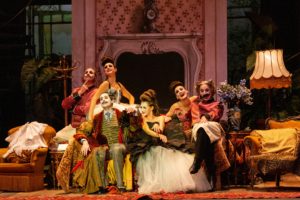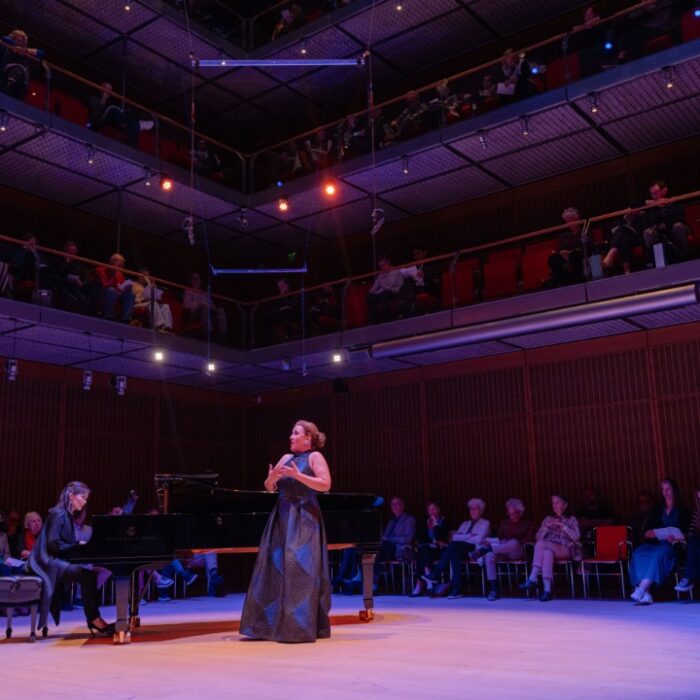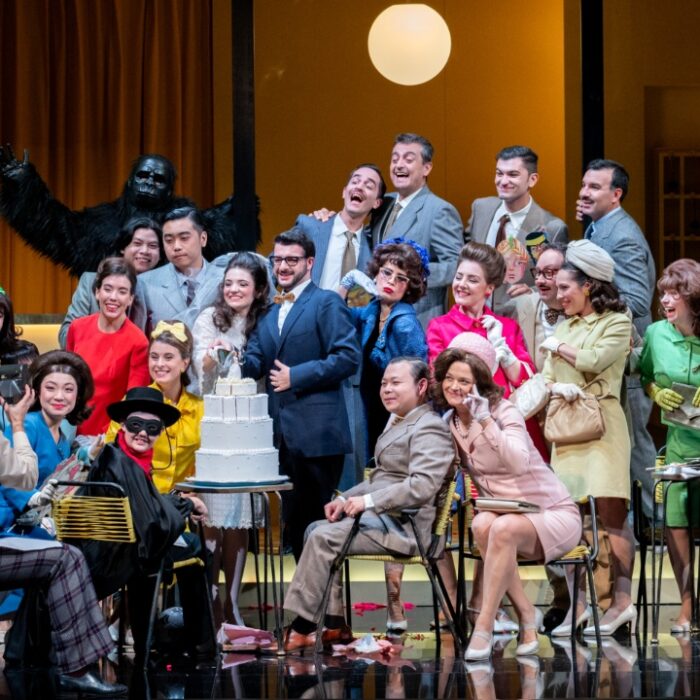
Théâtre Champs Elysées 2021-22 Review: La Vie Parisienne
Christian Lacroix’s Take on Offenbach’s Empty Operetta is a Visual Feast
By David Salazar(Credit; Vincent Pontet / Théâtres Champs Elysées)
Late in Offenbach’s operetta “La Vie Parisienne” the ensemble comes together to celebrate how Parisian life is all fun and games. And the work certainly sets out to explore how a cornucopia of people, Parisians and otherwise, come together to engage in role-playing, identity switches, sexual rendez-vous’, Mozart jokes, etc. On the surface it certainly supports its underlying message.
If only the opera itself as an experience matched this anthem.
The Théâtre des Champs-Elysées is in the midst of a holiday run of the operetta that initiated on Dec. 21, 2021 and is set to come to conclusion on Jan. 9, 2022. And while it was clear that audience members were engaging with the work, I found myself on the other side of the spectrum.
Top Notch Production
To be clear – the performance itself was top notch. Directed by Christian Lacroix, the stage of the great hall was filled up with a two-level set that was constantly transformed to suit the different locations called for. It In the first act we get a train station with the second act heading to a room in Gardefeu’s home before ending up at grand salon of Quimper-Karadec’s hotel, where we remain for two acts. Finally, the final act shifts (via a wonderful balletic transition to a restaurant). The production manages to retain a colorful quality throughout without ever feeling overbearing or bringing too much attention to itself. As such, Lacroix is able to maintain his actors upstage in prime locations where audience interaction is far easier. Blocking was solid overall and the sparse use of dance and some voguing allowed for those moments to shine.
The lighting for this production is also quite solid with some standout moments. When Madame Madame de Quimper-Karadec starts to interrupt the Baroness’ narrative, the lighting switches to a dark blue, a lone spotlight on her. The effect is comic in juxtaposing of the low key lighting with the overall high key established throughout the rest of the production. But what makes this story choice work so well is how it is later answered in the final act when Offenbach gives the audience a bit of a joke by quote the confrontation between Don Giovanni and the Commendatore from Mozart’s “Don Giovanni.” Once more, Lacroix employed a low key light, flooding one of the characters in silhouette to match the “ghostly” atmosphere, thus suggesting Quimper-Karadec’s wild imagination.
Perhaps the biggest draw for this production was the costuming which was exquisite throughout. Major characters constantly switched in and out of outfits, which only added to the visual vibrancy employed throughout.
Top Notch Performers
The performers, under the baton of Romain Dumas, were also solid overall. While there were some notable misfires early on musically with some soloists struggling to stay on pitch and others to be heard, things slowly but surely came together by the second Act with some singers really taking the lead and standing out. Among the major standouts was soprano Elena Galitskaya in the role of the maid Pauline who has a “tryst” with the philandering Baron. Pauline appears in the third Act and immediately disguises herself as a high society woman. Moreover, Pauline gets a lot of vocal opportunities to shine throughout this Act including a duet, a quintet, and a solo (couplet) in the final extended number. In each one, Galitskaya displayed a wide ranging vocal and actoral talent. Whether it be the smooth legato lines throughout the duet and couplet or the more biting rhythmic work, she displayed a gleaming tone that is meant for big things. Her high notes shone with a security rarely heard from any of the other singers onstage. Perhaps her most impressive moment came in the ensuing Act when faced with being caught for her philandering the previous night she concocts a story and pretends that the Baron is Jean, a coachman with who she has been engaged. She pulls him around and takes literal command of the scene, a task that Galitskaya was more than up for. Her role gets undercut thereafter, but she made such an impact in those two scenes that you missed her presence in the final act.
Eléonore Pancrazi also put in a fantastic shift as the elusive and seductive Metella. In a bright pink dress, she seemingly glided around the stage as her velvety tone caressed her Rondeau “Vous êtes ici…” This was perhaps the most arresting vocal moment of the evening.
Ditto for Marion Grange who managed a similarly evocative Fabliau in which she remarks on what she saw between a couple while walking the Parisian streets. Here, Grange blended one delicate legato line into the next with a creamy and earthy sound. It was one of the few “slow” pieces in the operetta (more than in a bit) and Grange allowed the listener to fully lavish in this remarkable bit of legato writing with expansive tempi and a feeling that she wanted to hold onto every line for dear life – a poignant reflection of the Baronness’ own feelings at that moment.
As the Baron, Frank Leugerinel really dug into the boisterous qualities of the character, amping his sound to 100 at every possible chance. It was a blunt performance to be sure and one lacking in nuance, but it produced some of the most comic moments of the evening. The same goes for Ingrid Perruche as Madame Quimper-Karadec whose character is as ridiculous as her name. Again, there was little subtle and the shtick could get a bit overdone, but it was effective and you can’t help but appreciate the commitment by Perruche throughout.
In other roles, Laurent Deleuil and Flannan Obé were solid Bobinet and Gardefeu respectively. These characters are the ones to drive the plot (or whatever exists of it) and they were particularly noticeable during their speaking moments. Damien Bigourdan, who plays multiple roles, stood out most as the Brazilian with a spot-on accent during his dialogues. He also showed great agility during his vocal numbers.
In the pit, Dumas kept the orchestra sounding fresh and light, the balance between singers and orchestra really finding itself stride in the second Act.
Not a Top Notch Work
So yes, the performers gave a really solid showcase and one could argue that they made a case for the piece, assuming one needed to be made.
And yet I couldn’t help but wonder at it all. The piece itself, while light and fun in some moments (especially at the end), drags on forever. The first three acts are nothing more than a setup of the multitudes of characters to the point that you quickly lose sense of who is who and what exactly they want. A party takes place in the third act, but nothing of consequence comes of it until the fourth Act, which incidentally comes after the intermission. And then it’s just the usual comedy of errors of misplaced identity, some role reversals, etc. A fifth Act switcheroo is shoehorned into the plot to reconcile the philandering Baron with his wife and then everyone celebrates a bit.
To make matters more problematic is that this opera was rather revelatory in the concept of “show, don’t tell.” In cinema, this rule is used as scripture for filmmakers to avoid the trap of explaining things to the audience when they can simply show it to them, thus creating greater immersion. Opera by its very nature (and theater in general) relies heavily on telling, but this operetta made me realize that even then, there is a divide. Because in most operas, the music is doing the showing, even if a character is explaining an event. Take “Il Trovatore,” an opera lambasted for its plot and its constant reliance on characters to explain the plot. However, even there, Verdi makes sure to make the music do the showing. When Azucena is telling us about how she kidnapped a boy and murdered her own, the music is exploring her inner turmoil, rising to fever pitch expressing her pain and suffering. We are seeing and learning about her character, her feelings, and her point of view even as she relates an event. Same goes for any other musical number – the character might be doing a lot of explaining, but the music is allowing the viewer to become immersed in the experience and the character’s point of view and feelings on the topic at hand.
Offenbach, unfortunately, does not display the same level of depth here (or anything close to the level of quality in “Les Contes d’Hoffmann). Instead, characters explain things about Paris to similarly jovial music that’s over almost as soon as it’s begun. We get some lines of dialogue and then we’re back to singing about another trivial item. One could argue that Offenbach was poking fun at the form itself, but in a modern context it goes from comic, to increasingly bizarre, to tiresome, repetitive, and predictable. We never actually learn what any of these characters feel or think about what they are singing because all of the endlessly jovial music is increasingly indistinguishable from itself; we eventually get an arioso with long legato lines in the second half of the opera but by then it’s too late and almost a one-and-done experience. There is no ebb and flow in the music and without those constant tonal shifts there can be no contrast or conflict; without that, there can be no characters and without characters we understand (much less care about), a three-and-a-half hour romp becomes anything but “fun and games.”
Throw in some of the stereotyping going on (the endless anti-immigrant jokes that really feel out of place in today’s world) and this is an operetta that, to my eyes, has not aged well. It probably would have benefitted from a few cuts in its opening three acts.
I will give the operetta credit for Offenbach’s “Don Giovanni” joke, which is perhaps the most sophisticated musical moment in the entire piece, but after three hours of “La Vie Parisienne,” suddenly hearing Mozart’s masterwork did little favors for the piece on hand (I honestly found myself wishing I was listening to “Don Giovanni” instead, which in turn might also speak to the, at this point, undeniable fact that this piece was simply not for me).
All in all, credit must be given to the performers who were clearly invested in the work at hand and having a blast.


